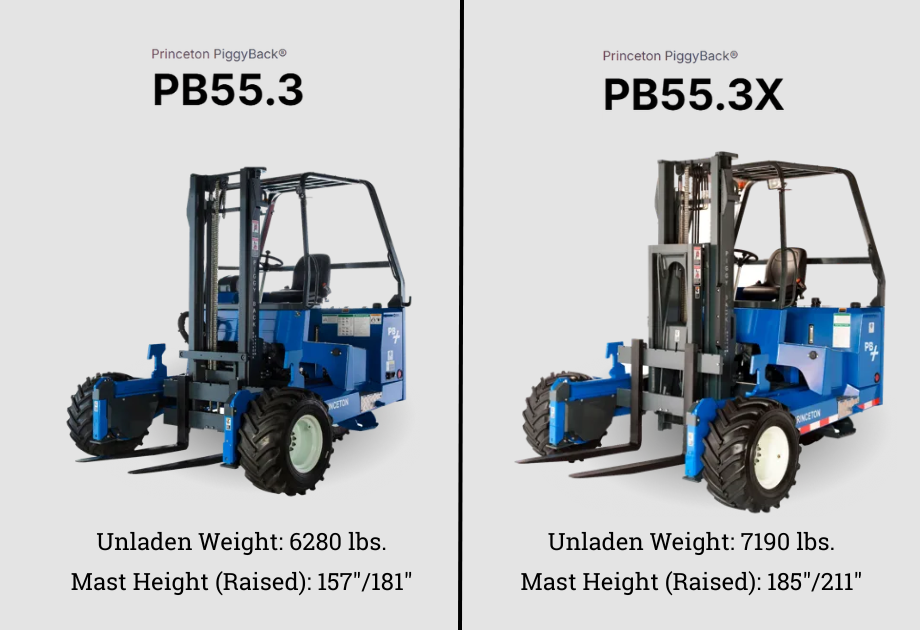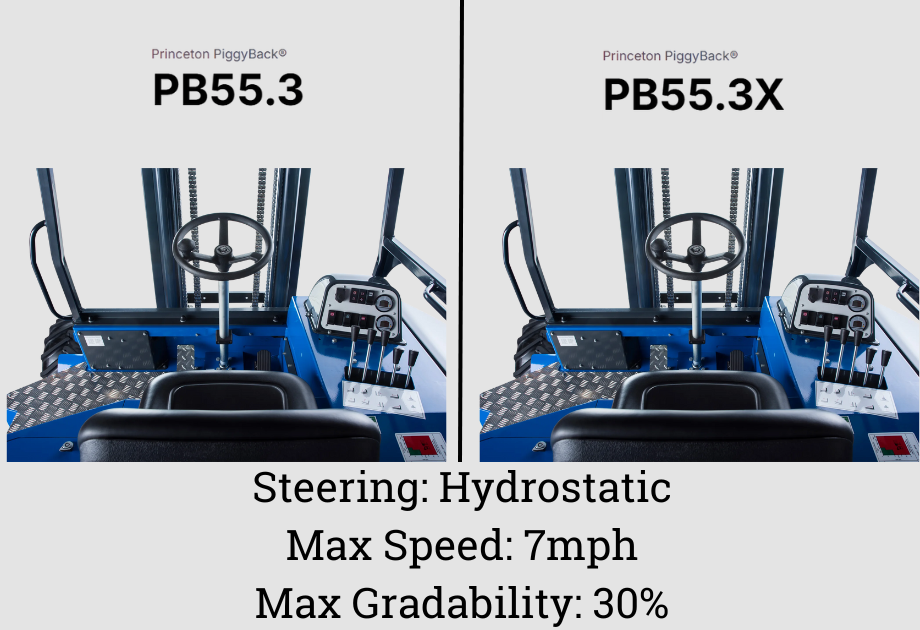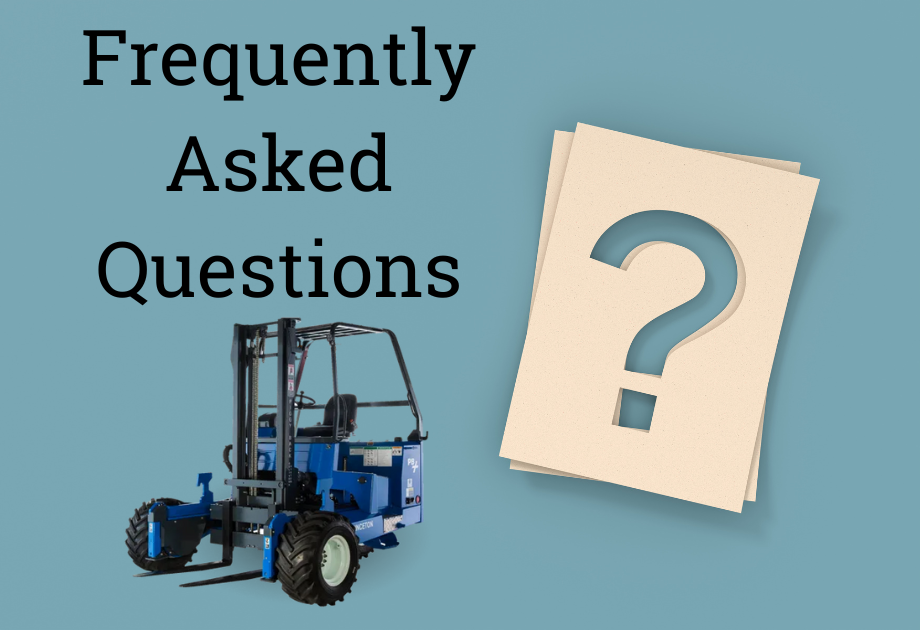PB55.3 vs. PB55.3X: Which Piggyback Forklift Is Right for Your Operation?
PB55.3 vs. PB55.3X: Which Piggyback Forklift Is Right for Your Operation?
(1).png)
When comparing truck-mounted forklifts, even small differences can affect performance on the job. The Princeton PB55.3 and PB55.3X are both reliable piggyback forklift options built for durability, power, and ease of use—but each one brings unique advantages depending on how and where it’s used.
This comparison outlines specs, handling, mounting, and real-world performance to help you choose the model that fits your operation best.
Understanding the Princeton PiggyBack® Lineup
Both the PB55.3 and PB55.3X belong to Princeton’s 55.3 series: designed for rugged use, fast mounting, and high-volume delivery. They share a 5,500 lb. lift capacity, three-wheel drive, and a diesel engine platform—but differ in footprint, reach, and terrain handling.
The Princeton PB55.3 is built with a smaller footprint and a lighter frame, making it easier to mount on shorter trailers or maneuver through tighter spaces.
The Princeton PB55.3X is longer, heavier, and often equipped with taller masts or larger tires to handle jobs with tougher terrain or longer load centers.
Core Specifications Breakdown

Specs alone won’t tell the whole story, but they give a strong foundation for comparing performance. While both machines fall within the same lifting class and use similar engine platforms, their size and structural layouts make them better suited for different kinds of jobs. You can view the full PB55.3 specs sheet and PB55.3X specs sheet to see exact mast configurations, load center ranges, and dimensions.
Let’s break down the most relevant spec categories to see how these two models differ in practice:
Lifting and Reach Capabilities
Both models lift 5,500 lbs. The PB55.3X supports longer load centers and is often paired with taller masts, making it a better choice for wide or stacked materials. The PB55.3 works well for standard pallet loads and shorter lift heights.
Machine Weight and Dimensions
The PB55.3X is heavier and longer, which affects trailer load limits and maneuverability in tight spaces. The PB55.3 offers more flexibility for compact sites and shorter trailers.
Engine and Transmission
Both forklifts run diesel engines—typically Kubota or Deutz—with no major difference in horsepower or drivetrain. Performance is consistent across the models.
Tire and Ground Clearance Options
The PB55.3X often features larger tires and higher clearance, making it a better fit for uneven ground or rougher terrain. The PB55.3 works well on level sites where mobility is the priority.
Mounting and Transport Considerations
Two forklifts with similar lift capacities can feel worlds apart once it’s time to mount them. If the model doesn’t align with your current trailer brackets, overhang limits, or DOT compliance needs, it could throw off your entire setup. Let’s take a closer look at how the PB55.3 and PB55.3X differ in mounting and transport.
Mounting Footprint and Travel Position
The PB55.3 mounts tighter to trailers, making it easier to work within space restrictions. The PB55.3X may require more clearance due to its longer frame.
Vehicle Compatibility
The PB55.3 fits smaller flatbeds and shorter trailers. The PB55.3X is better suited for larger trucks and fleets already running extended setups.
Daily Use and Operator Feedback

Specs and mounting logistics are important, but how a forklift performs once it’s fired up on the jobsite is what truly matters. The PB55.3 and PB55.3X are built for the same class of work, but operators will notice key differences in how they handle based on the jobsite and load type.
Visibility and Maneuverability
The PB55.3X can offer better load visibility with taller masts but feels bulkier in confined spaces. The PB55.3 is more agile and easier to position in tight delivery zones.
Comfort and Controls
Both models have similar control layouts. Operators sometimes report smoother joystick handling in newer PB55.3X units, but comfort is comparable overall.
Jobsite Applications and Use Case Fit
Choosing the right piggyback forklift isn’t just about specs or mounting—it’s about how well a machine fits your day-to-day environment. Different loading zones, material types, and delivery expectations call for different strengths. Here’s how the Princeton PB55.3 and Princeton PB55.3X stack up when it comes to real-world applications.
PB55.3 Use Cases
Best for jobs in tight urban areas, short travel distances, and operations where trailer size or weight is limited.
PB55.3X Use Cases
Ideal for heavy-duty deliveries, rough terrain, longer reach needs, and industries like construction, lumber, and landscaping.
Long-Term Maintenance and Ownership Experience
For most buyers, the forklift itself is only part of the investment. Ongoing service needs, part availability, and resale value all play a role in how a machine performs across its lifespan. Both the Princeton PB55.3 and Princeton PB55.3X are designed to last, but long-term ownership considerations can still tip the scales when deciding which model suits your operation.
Service and Parts
Both forklifts require regular maintenance, including oil changes every 250 hours and routine hydraulic, tire, and mast checks. We stock parts for both models and offer full repair and service support to minimize downtime.
Customization and Resale
Each model can be tailored with different masts, tires, and carriage options. We help spec machines for long-term use and offer reconditioning for stronger resale value. Beamer’s also buys and sells used models and supports fleet upgrades.
Answers to Common Questions

Before making a purchase, most buyers come to us with a few recurring questions about piggyback forklift ownership, not just how the PB55.3 and PB55.3X compare. Here’s a quick rundown to help clarify common concerns and support confident decision-making.
Are these forklifts indoor-capable?
Not typically. Diesel engines and overall size make them better suited for outdoor use. Indoor operation requires large, ventilated spaces.
Can Princeton forklifts be customized?
Yes. We can help with mast heights, tires, lighting, and mounting compatibility.
What safety features are included?
Standard features include ROPS, seatbelt interlocks, horns, lights, and operator presence systems. We offer upgrades like backup alarms and cameras.
Are certified pre-owned models available?
At time of publishing, we offer new PB55.3 and PB55.3X forklifts. If you're looking for used units, you can keep an eye on our current inventory for updates. Listings are refreshed regularly as equipment becomes available.
How often should they be serviced?
Standard service is due every 250 hours. We offer both in-shop and field maintenance to keep your equipment running strong.
Get the Right Piggyback for Your Operation with Beamer’s Piggyback
Whether you’re drawn to the compact build of the Princeton PB55.3 or the extended reach and rugged presence of the PB55.3X, our team at Beamer’s is here to help you choose the right forklift for the job. We offer new Princeton PiggyBack® PB55.3 units and certified pre-owned PB55.3X models—each backed by experienced technicians and real-world insight.
We’ll walk you through technical specs, mounting requirements, and truck compatibility, so you can invest with confidence and avoid trial-and-error guesses. If you're ready to upgrade your fleet, contact us today or check out our current inventory.
We don’t just move forklifts—we help build equipment strategies that work.
